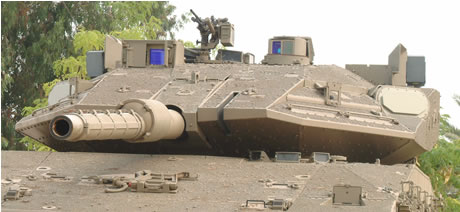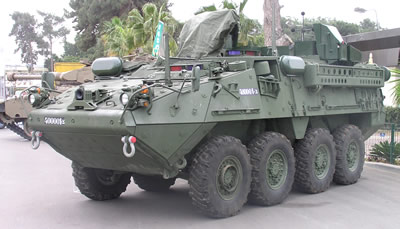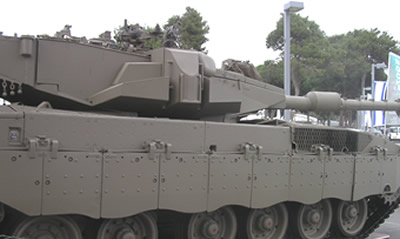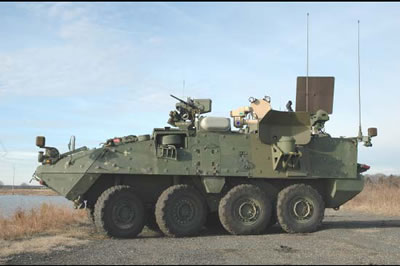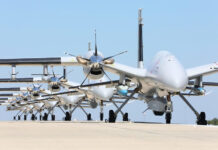 The Trophy Active Defense System (ADS) was developed by RAFAEL under an Israel Defense Research & Development Directorate (DRDD) support, aiming to provide armored vehicles with a new level of protection against most current anti-tank threats. RAFAEL cooperated with IAI/Elta and has signed a marketing agreement with General Dynamics, offering the system to US and other armies worldwide. GD planned to introduce the system with every new and existing combat vehicle it produces, including Stryker, M-1A2 and FCS. According to GD officials, the system can be adapted to US requirements and enter production within two years. through hundreds of live firing tests with the Israel Defense Forces and abroad, where the system demonstrated effective neutralization of anti-tank rockets and guided missiles, high safety levels, insignificant residual penetration and minimal collateral damage. By mid 2007, Trophy was selected to equip the Israeli Merkava Mk4 main battle tanks, and it is also a candidate for integration into the Namer, the future Merkava based Armored Infantry Fighting Vehicle. The system is also considered to become part of the protection suite of future light armored vehicle (such as the Stryker) when these become operational with the Israeli Army.
The Trophy Active Defense System (ADS) was developed by RAFAEL under an Israel Defense Research & Development Directorate (DRDD) support, aiming to provide armored vehicles with a new level of protection against most current anti-tank threats. RAFAEL cooperated with IAI/Elta and has signed a marketing agreement with General Dynamics, offering the system to US and other armies worldwide. GD planned to introduce the system with every new and existing combat vehicle it produces, including Stryker, M-1A2 and FCS. According to GD officials, the system can be adapted to US requirements and enter production within two years. through hundreds of live firing tests with the Israel Defense Forces and abroad, where the system demonstrated effective neutralization of anti-tank rockets and guided missiles, high safety levels, insignificant residual penetration and minimal collateral damage. By mid 2007, Trophy was selected to equip the Israeli Merkava Mk4 main battle tanks, and it is also a candidate for integration into the Namer, the future Merkava based Armored Infantry Fighting Vehicle. The system is also considered to become part of the protection suite of future light armored vehicle (such as the Stryker) when these become operational with the Israeli Army.
During the first months of 2009 the Trophy system went through comprehensive operational testing and was cleared for operational use after a successful operational firing test conducted early August 09. By the end of the year all new Merkava Mk4 tanks will be equipped with the system. Until then, Trophy is being retrofitted to operational tanks.
The Trophy active protection system creates a hemispheric protected zone around the vehicle where incoming threats are intercepted and defeated. It has three elements providing – Threat Detection and Tracking, Launching and Intercept functions. The Threat Detection and Warning subsystem consists of several sensors, including flat-panel radars, placed at strategic locations around the protected vehicle, to provide full hemispherical coverage. Once an incoming threat is detected identified and verified, the Countermeasure Assembly is opened, the countermeasure device is positioned in the direction where it can effectively intercept the threat. Then, it is launched automatically into a ballistic trajectory to intercept the incoming threat at a relatively long distance.
Specific details about the composition and mechanism of this explosive interceptor device are vague. From the briefing provided by US sources, Defense Update understands that Trophy is design to form a “beam” of fragments, which will intercept any incoming HEAT threat, including RPG rockets at a range of 10 – 30 meters from the protected platform. The Trophy development roadmap considers an enhanced countermeasure unit to be available in the future, and protect against kinetic energy (KE) threats. Trophy was designed to effectively operate in a dense urban environment, where armored vehicles operate closely with integrated infantry forces. Therefore, direction, formation and energy of the fragments are designed to ensure effective target kill with low collateral damage, and low risk to nearby troops. While not in use, the system is maintained in the stowed position, protected by an armor shield. The system has an automatic reload mechanism to handle multiple attacks.
The system can simultaneously engage several threats, arriving from different directions, is effective on stationary or moving platforms, and is effective against short and long range threats (such as RPGs and ATGM). Trophy was designed to be effective in open or closed terrain, including urban area and can be operated under all weather conditions.
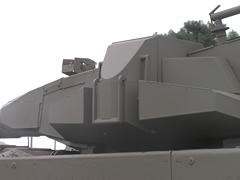 On March 30, 2006 General Dynamics announced the successful completion of a firing test, conducted at the request of the Office of the Secretary of Defense’s Office of Force Transformation (OFT), to validate the Israeli Army’s tests that demonstrated Trophy’s ability to detect, track and destroy incoming rocket propelled grenades (RPG) at safe distances from the host vehicle. Trophy underwent this U.S. validation testing in support of OFT’s Project Sheriff, or the Full-Spectrum Effects Platform (FSEP). FSEP program officials seek to meet urgent operational requirements for a range of lethal and non-lethal technologies on a rapidly deployable platform. Trophy was selected in 2005 to be FSEP’s active protection solution. During the test, Trophy detected, tracked and defeated an inert incoming RPG while the Stryker combat vehicle was on the move. Similar tests were successfully conducted in Israel in late February.
On March 30, 2006 General Dynamics announced the successful completion of a firing test, conducted at the request of the Office of the Secretary of Defense’s Office of Force Transformation (OFT), to validate the Israeli Army’s tests that demonstrated Trophy’s ability to detect, track and destroy incoming rocket propelled grenades (RPG) at safe distances from the host vehicle. Trophy underwent this U.S. validation testing in support of OFT’s Project Sheriff, or the Full-Spectrum Effects Platform (FSEP). FSEP program officials seek to meet urgent operational requirements for a range of lethal and non-lethal technologies on a rapidly deployable platform. Trophy was selected in 2005 to be FSEP’s active protection solution. During the test, Trophy detected, tracked and defeated an inert incoming RPG while the Stryker combat vehicle was on the move. Similar tests were successfully conducted in Israel in late February.
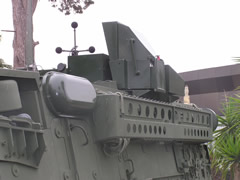 September 2006: The US Army opted to pursue a different system. Earlier in 2006, Raytheon received a development contract to demonstrate and develop the Quick Kill APS, to be integrated into the future FCS systems. The Army faced mounting criticism about not considering the Trophy system for the protection of its armored vehicles deployed in Iraq. Maj. Gen. Jeffrey A, Sorenson, the Army’s deputy for acquisition and systems management explained the decision (AFPS) saying the Israeli system is not a “produceable item.” The Israelis have been working on the Trophy system for 10 or 11 years, Sorenson said. “If this thing was ready to go, my question would be, why wasn’t it on the particular tanks that went into Lebanon?” he said. No Israeli Merkava tanks carried the Trophy system, he said.
September 2006: The US Army opted to pursue a different system. Earlier in 2006, Raytheon received a development contract to demonstrate and develop the Quick Kill APS, to be integrated into the future FCS systems. The Army faced mounting criticism about not considering the Trophy system for the protection of its armored vehicles deployed in Iraq. Maj. Gen. Jeffrey A, Sorenson, the Army’s deputy for acquisition and systems management explained the decision (AFPS) saying the Israeli system is not a “produceable item.” The Israelis have been working on the Trophy system for 10 or 11 years, Sorenson said. “If this thing was ready to go, my question would be, why wasn’t it on the particular tanks that went into Lebanon?” he said. No Israeli Merkava tanks carried the Trophy system, he said.
Other problems include the fact that the system right now has no reloading capability. Once it fires, that side of the vehicle is vulnerable. Which brings up another shortcoming: the Trophy can only be mounted to protect one axis. This means officials would have to mount multiple missile systems on every vehicle. The Quick Kill missile has 360-degree capability and a reload capability.
Another worry is collateral damage, he said. “In a tight urban area, the Trophy system may take out the RPG, but we may kill 20 people in the process,” Sorenson said. “That is a concern we have that we haven’t fully evaluated.”
However, an NBC report aired May 7, 2007 claims that in contrast to Sorenson’s observations, in a recent study made by the Institute for Defense Analyses (IDA) requested by the Office of the Secretary of Defense, following a law passed by the US Congress, Trophy was found to be “in an advanced state of development” (with a TRL of 7-8). while Raytheon’s Quick Kill was judged a 3 for threshold capabilities (RPGs, ATGMs).
April 2007: The development of the Trophy Active Protection System has been completed, including integration of the system into current AFVs as well as the introduction of reloading systems, positioning the Isaeli active protection system as the first available system in the West. Initial systems are expected to go into new production and currently deployed Merkava tanks as well as the new Merkava based armored Infantry Fighting Vehicles (Namer). While the system has been approved for production, which still awaits funding allocation. After the recent conflict in Lebanon (July-August 2006), Active Protection Systems were identified as a critical complement for the protection of main battle tanks such as the Merkava Mk4.
Trophy Light
a new version of RAFAEL’s active protection system, unveiled at RAFAEL’s display at DSEi 07 is based on the Trophy system, currently in production for Israel’s Merkava tanks. Trophy Light is designed for integration with light armored vehicles, such as RAFAEL’s Golan. The system will offer high probability of kill against advanced threats, including the most sophisticated shoulder-fired anti-tank rocket propelled grenades (RPG). The system utilizes the same operating principles of the Trophy, at scaled down proportions, facilitating installation on smaller, light armored vehicles, and operation at shorter ranges, therefore adapting to the typical operating environment of light armored vehicles. According to sources at RAFAEL, the development is a low-risk endeavor, as Trophy Lite will require only design and engineering work on the launcher/ loader and munitions. It is expected to weigh about half the weight of the standard Trophy, originally designed for main battle tanks. The system will use the same Elta radar used with the Trophy, and will employ electronic enhancements contributing to significant improvement in combat effectiveness. Trophy Lite is also expected to cost less, positioning it at a competitive advantage in the growing APS market.

